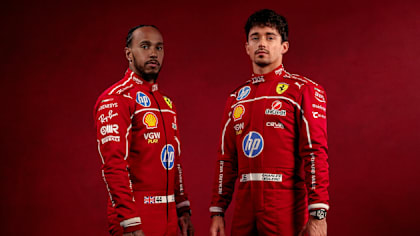McLaren's new 'predatory' grey livery might be their first significant change in almost two decades, but they weren't always so consistent. We look back at the history of their colour schemes, including two one-offs and perhaps the most iconic of them all...
Green shoots

Bruce McLaren (NZL) McLaren M2B, DNF, leads Jo Bonnier (SWE) Cooper T81, DNF. Monaco Grand Prix, Monte Carlo, Monaco, 22 June 1966
Eschewing the traditional idea of competing in national colours, Bruce McLaren's eponymous team made their Formula One racing debut at Monaco in 1966 using a white colour scheme with a central green stripe. This enabled the New Zealander to double as Pete Aron, the lead character from John Frankenheimer’s ‘Grand Prix’ movie, which was filmed throughout the summer of '66. The convention would have been to paint the M2B in New Zealand's nominal racing colours of green, black and silver.
One-off red

Bruce McLaren (NZL) McLaren BRM M5A, 7th place. Formula One World Championship, Rd8, Canadian Grand Prix, Mosport Park, Canada. 27 August 1967. BEST IMAGE
A year later and McLaren switched to a one-off colour scheme of red with a pale central stripe for Canada's inaugural Formula One Grand Prix. Bruce qualified sixth in the Ferrari-esque car and was in the mix for victory at quarter distance, only to fall back as a wet track gradually dried.
Orange is born

Denny Hulme (NZL), McLaren M7A, won the race after starting from 6th on the grid. Canadian Grand Prix, Rd10, Mont-Tremblant, Canada. 22 September 1968. BEST IMAGE
Inspired by rival liveries in Can-Am sports cars, and keen to stand out from the pack, McLaren made the historic decision to switch to orange. The team's F1 cars sported the striking colour scheme in 1968, when they also became a winning force, triumphing at Spa-Francorchamps, Monza and Mont-Tremblant. While the livery was in fact short-lived, staying only until 1971, it continues to be synonymous with the Woking team, as well as a firm favourite with fans.
Reverting to white

Denny Hulme (NZL) McLaren M19C used his CanAm knowledge of the circuit to qualify second and finish the race in third place. Canadian Grand Prix, Mosport Park, 24 September 1972. BEST IMAGE
The arrival of Yardley as sponsors led to another change of livery for McLaren in 1972. Though they didn't totally dispense with the papaya orange, keeping a small strip on the sidepods, the car was once again predominantly white - a combination the team kept, with minor modifications, for the following season.
The might of red and white

Emerson Fittipaldi(BRA)McLaren M23 US Grand Prix, Watkins Glen, 6th October 1974
Emerson Fittipaldi's arrival at McLaren in 1974 signalled a major change of direction in terms of livery, as sponsorship deals sparked the iconic red and white blend that would adorn the team's cars for the next two decades. The period would also coincide with some of McLaren's most successful and iconic years, including of course the Ayrton Senna-Alain Prost duels that came to define an entire F1 era.
The Portuguese exception

Keke Rosberg (FIN) McLaren MP4/2C failed to finish. The car was run in a one-off Marlboro Lights livery. Portugese Grand Prix, Estoril, 21 September 1986
A visit to Estoril in 1986 threw up a rare break from red and white, as McLaren adopted a yellow hue in a one-off livery for Keke Rosberg. The Finn qualified seventh but retired just after the half-way point. Team mate Alain Prost, running in the more traditional colours, started third and finished second to stay in contention for the drivers' crown.
The swansong

Mika Hakkinen(FIN) Mclaren MP4-11, 3rd place leads Damon Hill British Grand Prix, Silverstone, 14th July 1996
The 1996 season would be McLaren's last in red and white, ending a two-decade long association with the scheme. Mika Hakkinen and David Coulthard scored a collective six podiums over the 16 races, although victory eluded both men.
Silver linings

Mika Hakkinen (FIN) Mclaren MP4-12, 3rd place Formula One World Championship, Rd 10, German Grand Prix, Hockenheim, Germany, 27 July 1997.
The arrival of new sponsors sparked massive changes in 1997, with the team adopting a silver and black livery - complete with a strip of dayglo red on the underside of the nose. Coulthard prevailed in the MP4-12's first race at Melbourne, but slim pickings thereafter meant he and Hakkinen prevailed just once more each over the season. Though the colour scheme would be tweaked over the following seasons, it would essentially remain in place until 2015.
The chrome effect

Kimi Raikkonen (FIN) McLaren Mercedes MP4/21. Formula One World Championship, Rd 12, German Grand Prix, Race, Hockenheim, Germany, 30 July 2006. DIGITAL IMAGE BEST IMAGE
One of the more significant tweaks to the silver theme came in 2006, when McLaren ushered in a revolutionary new chrome livery complete with dayglo stripes running from the front nose to the rear of the car, and also along the top of the engine cover. The team would tweak the design further over the following seasons.
A temporary solution

www.sutton-images.com Jenson Button (GBR) McLaren MP4-30 at Formula One Testing, Day Four, Jerez, Spain, 4 February 2015. BEST IMAGE
McLaren began the 2015 campaign with chrome still adorning the top of the MP4-30's nose and the sides of the engine cover - but the sidepods were a much darker grey, enlivened only by a dayglo stripe running around the midriff. However, the livery - which Ron Dennis had warned could change - lasted just four races...
Predatory grey

© McLaren
McLaren unveiled their first fundamental livery change since 1997 as they dropped any hint of silver and instead opted for a darker 'graphite-grey' colouration, with more emphasis on the 'dayglo' keylines. For more information and images, click here.
All images © Sutton Motorsport Images, unless otherwise stated


)

.png)